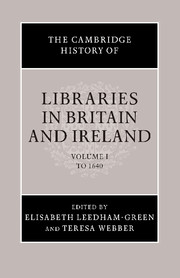Book contents
- Frontmatter
- Introduction
- The physical setting
- 1a The medieval library (to c. 1450)
- 1b The early modern library (to c. 1640)
- Part One The medieval library
- Part Two Reformation, dissolution, new learning
- Part Three Tools of the trade
- Part Four Libraries for leisure
- Part Five Organisation and administration
- Select bibliography
- General index
- Index of manuscripts
- References
1a - The medieval library (to c. 1450)
from The physical setting
Published online by Cambridge University Press: 28 March 2008
- Frontmatter
- Introduction
- The physical setting
- 1a The medieval library (to c. 1450)
- 1b The early modern library (to c. 1640)
- Part One The medieval library
- Part Two Reformation, dissolution, new learning
- Part Three Tools of the trade
- Part Four Libraries for leisure
- Part Five Organisation and administration
- Select bibliography
- General index
- Index of manuscripts
- References
Summary
Most ‘medieval libraries’ were not a single physical entity: rather they comprised a number of collections, often physically discrete, whose contents might shift from one to another, or be reconfigured, in response to changing needs and local conditions. The first library rooms – chambers in which books were not only stored but also consulted – usually held only a portion of the total collection, other parts being stored elsewhere. Throughout our period, where the collections were kept, how they were stored and the principles underlying their organisation were directly connected to their size, function and use. Nevertheless, other, less practical factors, ranging from inertia to the wishes of benefactors, could also come into play. In all but a few of the major religious communities, book collections were usually small, numbering hundreds rather than thousands; and in many institutions a proportion of the books would always be in the hands of individual members, reducing the number for which storage space was required. Most collections grew comparatively slowly (albeit in fits and starts), encouraging a series of ad hoc measures and expedients rather than radical restructuring. Thus, once a particular store had been settled upon, it was likely to have a long life. More dramatic change, when it came, was a response as much to new concepts of use as to the practicalities of storage.
- Type
- Chapter
- Information
- Publisher: Cambridge University PressPrint publication year: 2006
References
- 45
- Cited by



